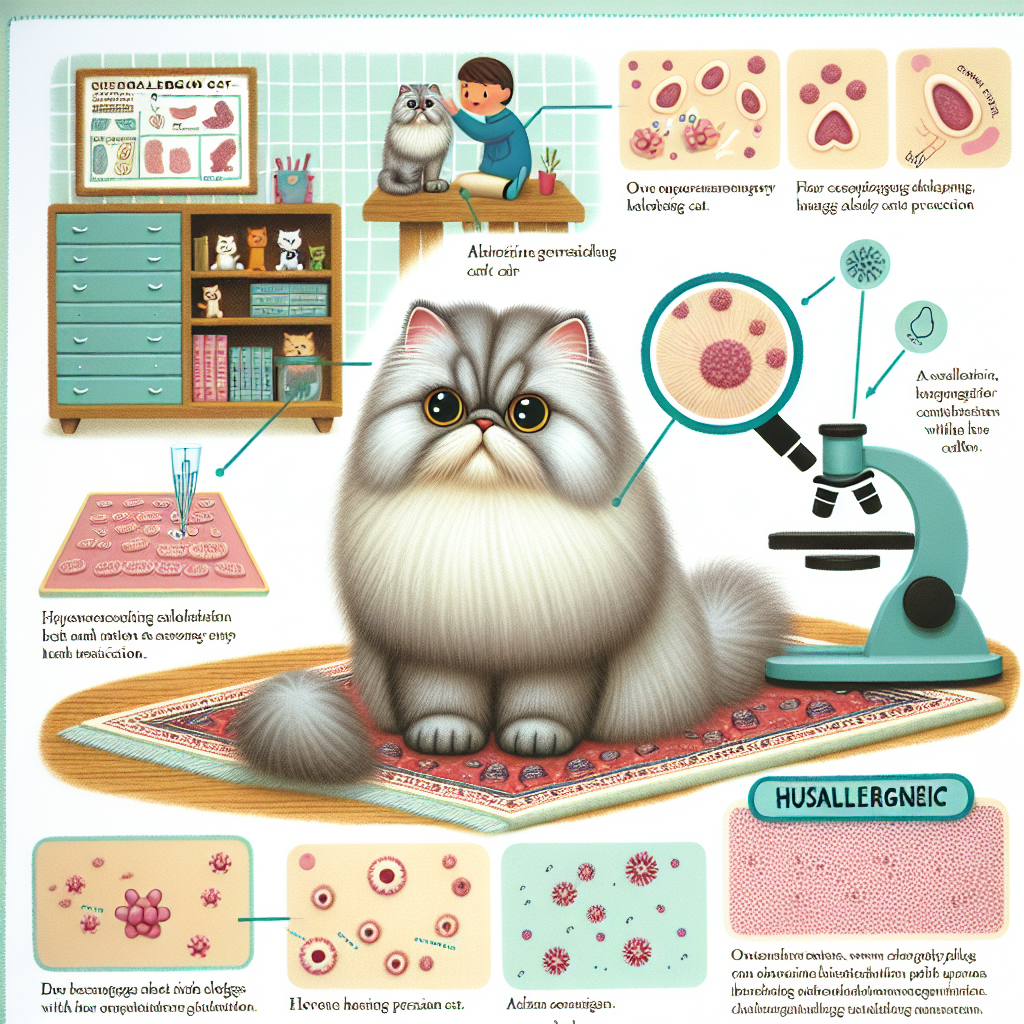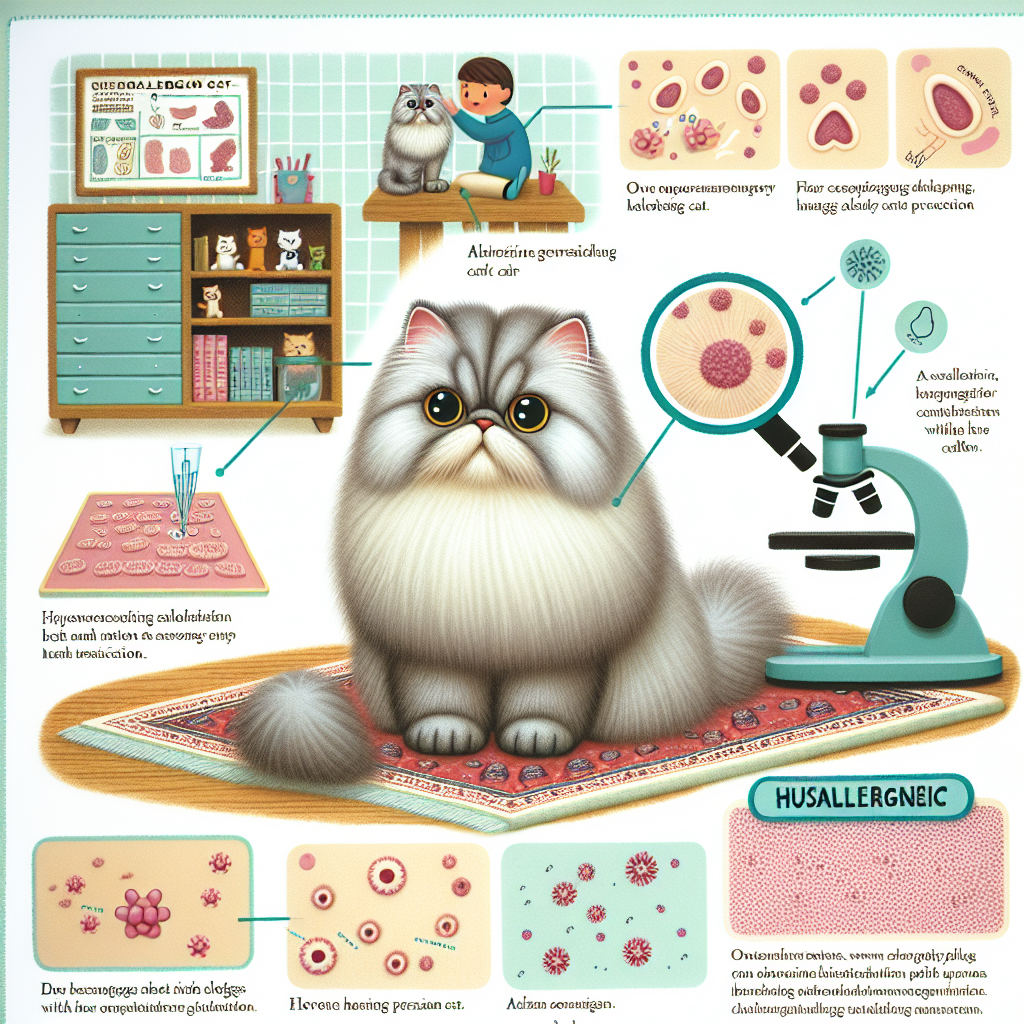Are you curious about the hypoallergenic properties of Persian cats? If you’ve ever wondered if these majestic felines can be a suitable companion for someone with allergies, then look no further. In this article, we will explore the hypoallergenic qualities of Persian cats and why they are often considered a better option for individuals prone to allergies. So, if you’ve been yearning to welcome a furry friend into your home but have concerns about allergic reactions, read on to discover the fascinating world of hypoallergenic Persian cats.
What Does Hypoallergenic Mean?
Definition
You may have heard the term “hypoallergenic” before, but what does it actually mean? Well, hypoallergenic refers to substances or products that are less likely to cause an allergic reaction in individuals who are sensitive or allergic to certain allergens. In the context of pets, hypoallergenic typically refers to breeds or animals that are less likely to trigger allergies in people who are allergic to pets.
How Does It Relate to Pets?
When it comes to pets, particularly cats, hypoallergenic refers to breeds that produce fewer allergens or substances that can cause an allergic reaction. These allergens are usually found in a cat’s skin cells, saliva, and urine. Hypoallergenic cats are often sought after by individuals with allergies who still want to experience the joy and companionship of owning a pet without suffering from severe allergies.
Understanding Allergies
Allergies are a result of the immune system reacting to substances that it perceives as harmful, even though they may be harmless to most people. When a person with allergies comes into contact with an allergen, their immune system overreacts and releases histamines and other chemicals that cause the symptoms of an allergic reaction. These symptoms can range from mild to severe and may include sneezing, coughing, itchy or watery eyes, skin rashes, and difficulty breathing.
The Allergen Source in Cats
Understanding Cat Allergen
In the case of cat allergies, the primary allergen responsible for triggering allergic reactions is a protein called Fel d 1. This protein is produced by the sebaceous glands in a cat’s skin and is present in their saliva, urine, and secretions from the anal glands. When a cat grooms itself, Fel d 1 proteins are deposited onto their fur, which can then become airborne and spread throughout the environment. This is why even if you don’t directly come into contact with a cat, you can still experience allergic symptoms.
Fel d 1 Protein
Fel d 1 protein is particularly problematic for individuals with cat allergies because it is a small and lightweight protein that can easily become airborne and remain suspended in the air for hours. It can also stick to clothing, furniture, and other surfaces, making it difficult to completely remove from your environment. People who are highly sensitive to Fel d 1 may experience allergies even in the presence of low allergen levels.
Other Allergens Found in Cats
While Fel d 1 is the main culprit when it comes to cat allergies, there are other allergens that can contribute to allergic reactions as well. These include other proteins found in a cat’s skin, as well as allergens from their dander, urine, and saliva. Each individual may have different sensitivities to these allergens, which is why some people may be more allergic to cats than others.

Fact or Fiction: Persian Cats and Allergies
Popular Misconceptions
One common misconception is that Persian cats are completely hypoallergenic or non-allergenic. While it is true that Persian cats are known for producing fewer allergens compared to other breeds, they are not completely allergen-free. Some people may still experience allergic reactions when exposed to Persian cats, although the severity of the reaction may be lower compared to other breeds.
Difference Between Hypoallergenic and Non-Allergenic
It’s important to understand the difference between hypoallergenic and non-allergenic when it comes to pets. Hypoallergenic breeds, like Persian cats, may still produce allergens but in lower quantities compared to non-hypoallergenic breeds. Non-allergenic breeds, on the other hand, are extremely rare and do not produce any allergens at all. It is crucial to note that no breed can guarantee a completely allergy-free experience for everyone.
Persian Cats and Allergy Sufferers
Despite not being completely hypoallergenic, many allergy sufferers have reported that they have a better tolerance for Persian cats compared to other breeds. This could be attributed to the fact that Persian cats produce less Fel d 1 protein, which is the primary allergen responsible for cat allergies. However, it is important for allergy sufferers to spend time with a Persian cat before making a decision, as individual sensitivities can vary.
The Hypoallergenic Properties of Persian Cats
Low Fel d 1 Levels
One of the main reasons why Persian cats are considered hypoallergenic is because they tend to produce lower levels of Fel d 1 protein compared to other breeds. This can be attributed to their long and dense coats, which may trap the protein and prevent it from being released into the environment. However, it’s worth noting that while Persian cats may produce less Fel d 1, they still produce other allergens that can trigger allergic reactions in sensitive individuals.
Reduced Dander Production
Another factor that contributes to the hypoallergenic properties of Persian cats is their reduced dander production. Dander consists of tiny flecks of dead skin that are shed by cats and can contain allergens. Persian cats have a more predictable shedding pattern and shed less dander compared to some other cat breeds. This can help reduce the allergen load in the environment and minimize allergic reactions in susceptible individuals.
Hair Length and Allergies
The length of a cat’s hair can also play a role in allergies. While it is commonly believed that long-haired cats like Persians may cause more allergies, the opposite may actually be true. The long hair of Persian cats has been found to help trap the allergens close to the cat’s body, reducing their release into the environment. However, it’s essential to note that every person’s allergies and sensitivities are different, so it’s crucial to spend time with a Persian cat before making a decision.

Management Strategies for Allergy Sufferers
Regular Grooming
If you’re an allergy sufferer considering a Persian cat, regular grooming is essential. Brushing your Persian cat’s coat frequently can help remove loose hair and dander, reducing the allergen load in your home. It’s best to groom your cat outside or in a well-ventilated area to minimize your exposure to allergens. Additionally, bathing your Persian cat regularly can also help remove allergens from their coat.
Air Purifiers
Investing in a high-quality air purifier can significantly improve the air quality in your home and reduce the concentration of allergens. Look for a purifier with a HEPA filter, as these are designed to capture tiny particles, including cat allergens. Place the purifier in the rooms where you and your Persian cat spend the most time to create a cleaner and more allergy-friendly environment.
Limiting Contact
While it may be challenging to resist cuddling and petting your Persian cat, limiting direct contact can help minimize allergic reactions. Avoid allowing your cat into your bedroom or other areas where you spend a lot of time, as this can help reduce allergen exposure. It’s also a good idea to wash your hands after interacting with your cat and avoid touching your face to prevent transferring allergens.
Tips for Choosing a Persian Cat as an Allergy Sufferer
Individual Sensitivities
Remember that everyone’s allergies and sensitivities are different, so what works for one person may not work for another. If you’re considering a Persian cat as an allergy sufferer, spend time with different cats of this breed to see how your body reacts. Some individuals may find that they have a higher tolerance for Persian cats, while others may still experience allergic symptoms. It’s important to find the right match for your specific needs.
Testing Allergic Reactions
If you’re uncertain about your allergies to Persian cats, consider getting tested by an allergist. Allergy testing can help identify specific allergens that trigger your symptoms, including cat allergens. This information can be valuable in determining whether a Persian cat would be a suitable companion for you. It’s always better to be informed and make an educated decision that takes your allergies into consideration.
Researching Breeders
When choosing a Persian cat, it’s essential to research and look for reputable breeders who prioritize breeding cats with hypoallergenic traits. A responsible breeder will be transparent about their breeding practices and provide information about the lineage and health of their cats. By choosing a reputable breeder, you increase your chances of finding a Persian cat with reduced allergens and a better compatibility with your allergies.
Other Hypoallergenic Cat Breeds
While Persian cats are known for their hypoallergenic properties, there are other cat breeds that are also considered hypoallergenic and may be suitable for allergy sufferers.
Siberian Cats
Siberian cats are known for producing lower levels of Fel d 1 protein, making them a popular choice for individuals with cat allergies. These cats have a thick, water-repellent coat that may help reduce the spread of allergens. However, as with any breed, individual sensitivities should be considered, and spending time with a Siberian cat before making a decision is crucial.
Balinese Cats
Balinese cats are often considered hypoallergenic due to their lower production of Fel d 1 protein. They are known for their long and silky hair and have been reported to cause fewer allergic reactions in some individuals. However, as allergies are highly individual, it’s important to spend time with a Balinese cat to determine how your body reacts to them.
Russian Blue Cats
Russian Blue cats have a reputation for producing lower levels of allergens compared to other breeds. Their short and dense coat may help reduce the spread of allergens in the environment. Many allergy sufferers have reported being able to tolerate Russian Blue cats more easily compared to other breeds, but individual sensitivities still play a significant role.
Hypoallergenic Myths Debunked
100% Hypoallergenic Breeds
It’s crucial to debunk the myth that there are 100% hypoallergenic cat breeds. While certain breeds, such as Persians, Siberians, Balinese, and Russian Blues, are known to produce fewer allergens, they are not completely allergen-free. The term “hypoallergenic” should be understood as a relative term, meaning that these breeds are generally less likely to trigger allergies compared to other breeds, but individual responses may still vary.
Hypoallergenic Cats and Asthma
Another myth surrounding hypoallergenic cats is that they are safe for individuals with asthma. While hypoallergenic breeds may produce fewer allergens, these allergens can still trigger asthma symptoms in individuals with asthma. It’s important for individuals with asthma to consult with their healthcare provider before bringing any pet into their home, hypoallergenic or not.
Other Methods to Reduce Allergies
While choosing a hypoallergenic cat breed can help reduce allergen exposure, there are other methods you can incorporate to further minimize allergic reactions. Keeping your home clean and free of dust, using allergen-proof bedding and covers, and regularly vacuuming and dusting can all help reduce allergens in your environment. Additionally, maintaining good indoor air quality, avoiding smoking, and managing humidity levels can also contribute to minimizing your allergies.
Living with a Persian Cat and Allergies
Creating an Allergy-Free Environment
Living with a Persian cat as an allergy sufferer requires some adjustments to create an allergy-friendly environment. Regular grooming, using air purifiers, and limiting contact are essential steps. It’s also a good idea to designate certain areas of your home as cat-free zones, such as your bedroom, to provide a safe space where you can minimize allergen exposure.
Building Tolerance
Some individuals with allergies have reported that living with a Persian cat over time has helped them build up a tolerance to the allergens. This tolerance can result from decreased sensitivity to the allergen or the gradual desensitization of the immune system. However, it is important to note that building tolerance is not guaranteed, and individual experiences may vary.
Consulting with a Doctor or Allergy Specialist
Before deciding to bring a Persian cat into your home as an allergy sufferer, it is always recommended to consult with a doctor or allergy specialist. They can provide guidance specific to your allergies, help you understand any potential risks, and advise on the best management strategies for living with a Persian cat. Their expertise can help you make an informed decision and ensure your health and well-being are prioritized.
Conclusion
In conclusion, while Persian cats are not completely hypoallergenic or non-allergenic, they are often considered a better choice for individuals with allergies compared to other cat breeds. Their lower production of Fel d 1 protein, reduced dander production, and hair length can contribute to a decreased allergen load in the environment. However, it’s important to remember that allergies are highly individual, and what works for one person may not work for another. Spending time with Persian cats, understanding your own sensitivities, and consulting with experts can help you determine if a Persian cat is a suitable companion for you as an allergy sufferer. With proper management strategies and creating an allergy-friendly environment, living with a Persian cat can be a fulfilling and enjoyable experience for both you and your furry friend.

